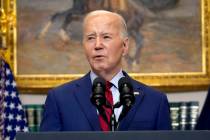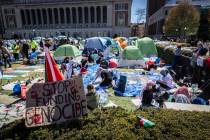We need residencies, not new medical school
Having served as a health care professional for more than 40 years, including the last 14 years in Southern Nevada, I have often heard the talk of the need for more medical schools. I find no surprise in the continued touting of such an idea by certain members of our community. But I also feel it is important to share my insights as a professional who has had direct responsibility for the development and management of health care programs over the course of my career.
The notion that the creation of a medical school in Southern Nevada will address all of our physician shortage issues is not only misguided, it is misinformed.
The conversation on this issue must begin with the understanding that Nevada already produces more than enough medical students to meet the state’s needs. Nevada currently has two four-year medical schools. Touro University Nevada, located in Southern Nevada, enrolls a total of 540 medical students, and the University of Nevada School of Medicine has more than 240 medical students.
The 2011 State Physician Workforce Data Book, published by the Association of American Medical Colleges, ranks Nevada 21st (and above the state median) for the number of medical students per 100,000 population. That same report lists Nevada 46th out of 50 states for the number of medical residents per 100,000 population. Because of the lack of post-graduate opportunities in Nevada, the overwhelming majority of our medical students leave Nevada for the next dimension of their education — residency training.
Touro University Nevada has been here for nearly 10 years and is positively and dramatically impacting the state’s health care environment. That same report by the AAMC ranks Nevada No. 1 in the percentage change in students enrolled in medical schools from 2000 to 2010. Touro’s opening in 2004 is directly responsible for this first-place ranking.
This data clearly demonstrate that Nevada doesn’t need another medical school. But Nevada does need residency programs — the hospital and clinic-based programs medical students train in after completing their four years of medical school.
The Association of Staff Physician Recruiters surveyed young physicians on their initial practice preferences, and nearly all those surveyed indicated that the geographic location of the practice is one of the first factors they consider when selecting a potential practice setting. Furthermore, an astounding 69 percent would establish their practice within 50 miles of where they did their residency program. It therefore stands to reason that if we create more residency programs, we will retain more medical students here in Nevada.
More importantly, we don’t need to invest taxpayer resources in creating a new medical school in Nevada. We must look at the costs of such an endeavor for the citizens of Nevada — people who are already facing significant financial woes. There are real costs associated with creating a new allopathic (M.D.) medical school — in addition to costs already budgeted at Southern Nevada’s universities. It is reasonable to estimate that these upfront costs would be in the tens of millions, if not the hundreds of millions, given the need to hire faculty and support personnel, and to construct laboratories, classrooms, lecture halls and clinical space.
But a central issue in this whole budget discussion — a point no one seems to be addressing — should be that the Liaison Committee on Medical Education requires start-up medical schools to provide documentation of adequate financial reserves to maintain this medical education program in the event of unexpected revenue losses. In layman’s terms, this means a new medical school would need to have millions set aside in a separate account in case the program fails and is required to arrange for enrolled students to transfer elsewhere to complete their medical education.
The only way we can truly address the need for more physicians is if Nevada’s hospitals expand current residencies and create new residencies that aren’t presently offered anywhere in the state. Such opportunities will keep our medical students in the state for the long-term and have a demonstrable impact on not only the physician shortage Nevada faces, but the anticipated influx of as many as 500,000 newly eligible patients under the Affordable Care Act.
I encourage Nevada’s legislative leaders, business community, hospitals and educators to take a long, hard look at what really needs to be done to address our state’s long-term health care needs. More important, I call upon the citizens of Nevada to voice their concerns over the misinformation being shared about this issue.
Michael Harter is senior provost and chief executive officer of Touro University’s Western Division.























